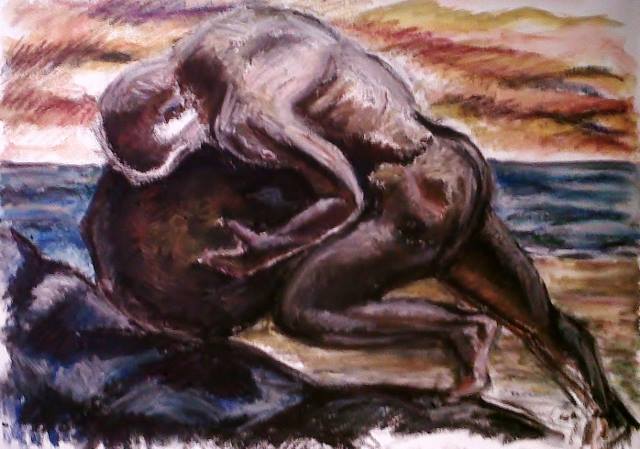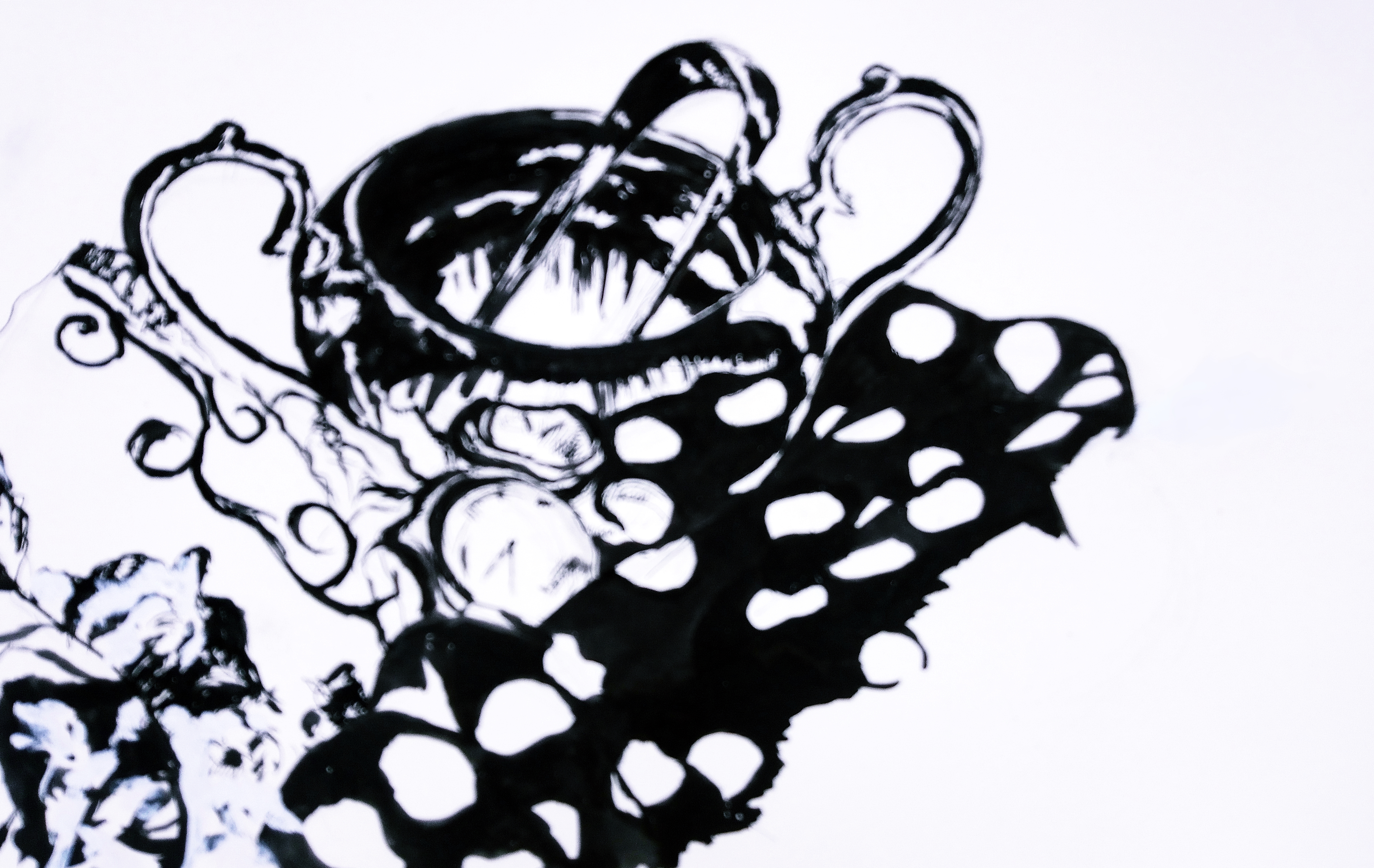
Figure 1: Sisyphus (2015) Own work [Oil pastel and water colour on paper, A3 size]
In this post, I will look at a series of events in my personal reflection. As a result, this post is more subjective in nature and longer than usual, but I had some sort of breakthrough yesterday and feel it is important to document that.
Towards the end of 2016, I decided to seek some professional advice on where to take my career. I had been completely freelance as a translator and academic editor since early 2013 and this was work that had been part of my life for far longer, extending back to my language degree, 2001-2005. Becoming freelance meant leaving full time teaching, thus enabling me to live where I wanted, which was France at the time. I was highly motivated to make it work, had already made inroads into the translation marketplace, and subsequently spent a few years working around the clock. The ongoing learning and sense of control over the kind of work I did; how I priced it, and how I dealt with my clients was deeply satisfying. Nevertheless, by 2015, I realised that I needed to work towards something beyond this: a career is more than a series of deadlines. I had become like the mythological Sisyphus, repeatedly rolling a huge boulder up a hill (see Figure 1, above). The novelty of working freelance and immersing myself completely in languages and writing was wearing thin. The work itself needed to move in some sort of direction.
As a result of reaching this watershed, I subscribed to a credible online counselling service, so that I could explore my aspirations and need for career fulfilment with someone neutral, professionally trained and highly educated in an academic sense. What I discovered from this experience was that 1) I needed to pursue my marginalised artistic side and develop it on another level and 2) that I could work things out by writing about them. This was brought to my attention by my counsellor. I took note and have since endeavoured to apply this tool. The Research & Enquiry module is therefore highly relevant to my own development, as it looks at reflection as a tool of the practitioner (Willcox and Adams, 2016a), enacted via writing in response to reading, observing, looking, listening and doing. Writing could even be seen as the textual equivalent of drawing.
Coming from a Fine Art background, I was trained to use drawing as a means of ‘feeding the imagination’, working things out, or visual reflection and in these initial stages of the course, I have been intensively involved in a cyclic process of drawing, reading, writing and interacting with others, such as peers and tutors. I identified a potential keyword, ‘ephemera’, early on, so that I had a point of departure for my practical exploration. I shared this in an email exchange with the course leader, Dr.Barbara Brownie. For me, ‘ephemera’ conjured up all kinds of highly aesthetic images of the passing of the year, seasons of life, feelings, fashion and so on. Barbara made other suggestions, such as collecting found objects or thinking about ephemera in more contemporary terms. I realised that I had a very set view of illustration and what I thought I wanted to achieve within it, although the bulk of that particular enquiry will inform Practice 1 on this course.
In a further Research & Enquiry lecture (Willcox and Adams, 2016b), it was highlighted how difficult it usually is for artists to answer questions about what they are trying to achieve in their work. In fact, the answer is often complex. However, on a Creative Arts MA, it is essential to ask ourselves why we make certain creative decisions and what draws us to the work of specific people. Therefore, a blog of this nature forms part of that interrogative process. As a fine artist, I have a very different approach and although there are many valuable skills and insights that fine artists can bring to illustration, it is important to understand the difference between the two worlds. In illustration as a discipline, Male (2017) defines the core components of the illustrator’s approach as the rationale, aim and objective (the ‘Why?’, ‘What?’ and ‘How?’). Illustration is therefore driven by a distinct rationale, unlike Fine Art, which is arguably ‘Art for art’s sake’.
Yesterday, I was working on some sketchbook drawings and the first was purely a celebration of a tree outside the building where I live, just as the afternoon sun bathed it and brought out the colours of the first autumn leaves (see Figure 2, below).

Figure 2: Autumn Tree, Rue de Falaise, Caen, France (2017) Own work [oil pastels on paper, A4 size]
The image is purely about responding to the tree en plein air and anything else expressed is purely incidental. It could certainly be adapted or integrated into other work, but then it would become something else.
The second drawing I made was also exploratory, although I had some ideas of creating an expressive face. I looked at a few images and videos of individuals with strong bone structure and expressive features, but moved between media (see Figure 3, below).

Figure 3: Sad Blue Face (2017) Own work [drawing ink, soft pastel, pencil and white paint on paper, A4 size]
I realised that I had created what I had set out to do, but had failed to take full ownership of that process. It was my ‘Aha!’ moment – the fine line between illustration and art for art’s sake. The starting point for an illustrator is that connection with the rationale. This represents a paradigm shift for me and at the moment, it feels strange trying to articulate the two different approaches and switch modes, but it is a start.
MALE, A (2017) Illustration. A Theoretical & Contextual Perspective, 2nd ed. Bloomsbury Publishing plc.
WILLCOX, I. and ADAMS, S. (2016a) Research & Enquiry Lecture 1, University of Hertfordshire School of Creative Arts. viewed at: https://vimeo.com/185805122 [Accessed October 12, 2017].
WILLCOX, I. and ADAMS, S. (2016b) Research & Enquiry Lecture 2, University of Hertfordshire School of Creative Arts. viewed at: https://vimeo.com/185805122 [Accessed October 13, 2017].

Interesting your reflections about the role of the Artist versus the one of the illustrator, and how you try to find a way out. I have shared both roles for many years , and probably this leads to a sort of artistic double personality. I think the effects of this tension between 2 poles – art and illustration- can be used as the matter of the images themselves. This double language will always exists, if one has experienced both field. I think that yours will be an added value, to be an Artist who enters Illustration, as you will inject the freedom of the artist into a more ‘directed’ image. Many years ago the Illustrator was very much directed by the client and by the art – director, but today he has an Authorial role, so…. it is good to enter Illustration just now!
LikeLiked by 1 person
Hi Paola,
Thank you for your thoughts!
Yes, for sure, it is like a dual personality – a bit like switching between headphone and speaker modes on my laptop! For me, it is a distinct pendulum swing, although I know fine artists who feel that they are in an interdisciplinary area, crossing into illustration. However, I would say that these particular individuals are always fine artists, as they are not connecting with a rationale other than their need to make art that means something to them. I thought it is an interesting time to enter illustration, due to the endless ways to publish and communicate with a wider audience, such as social networking, self-publishing and the virtual domain in general. However, it is interesting what you say about self-authoring. I noticed that a few people have mentioned this since I started the course.
LikeLiked by 1 person